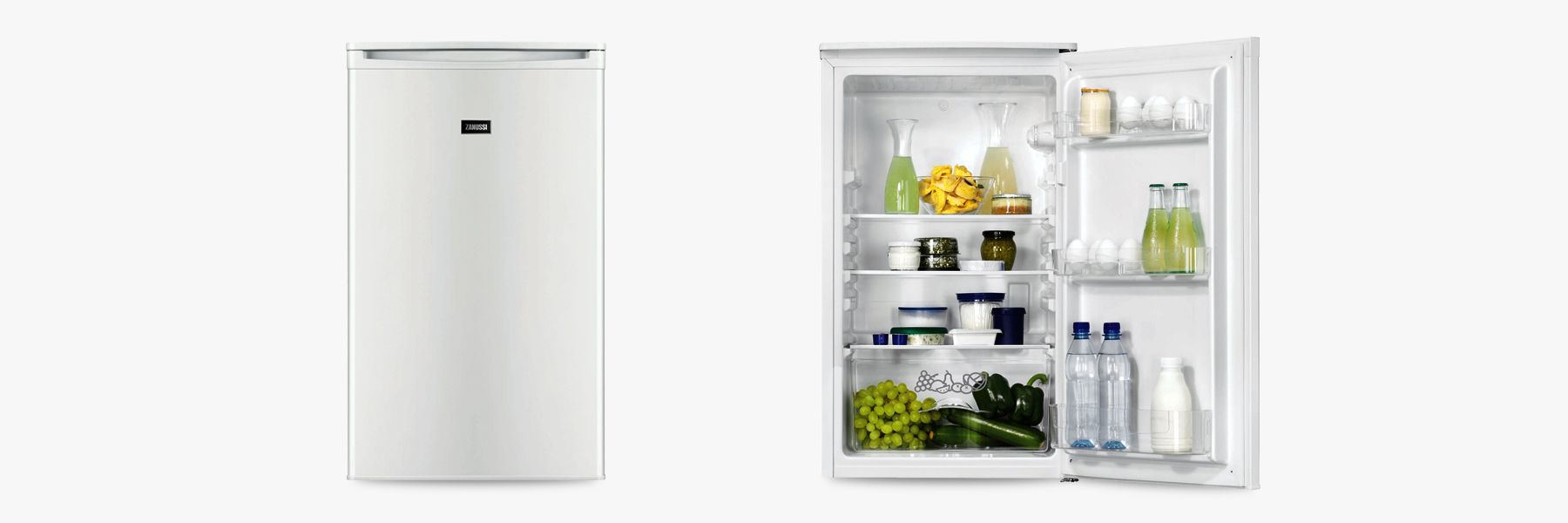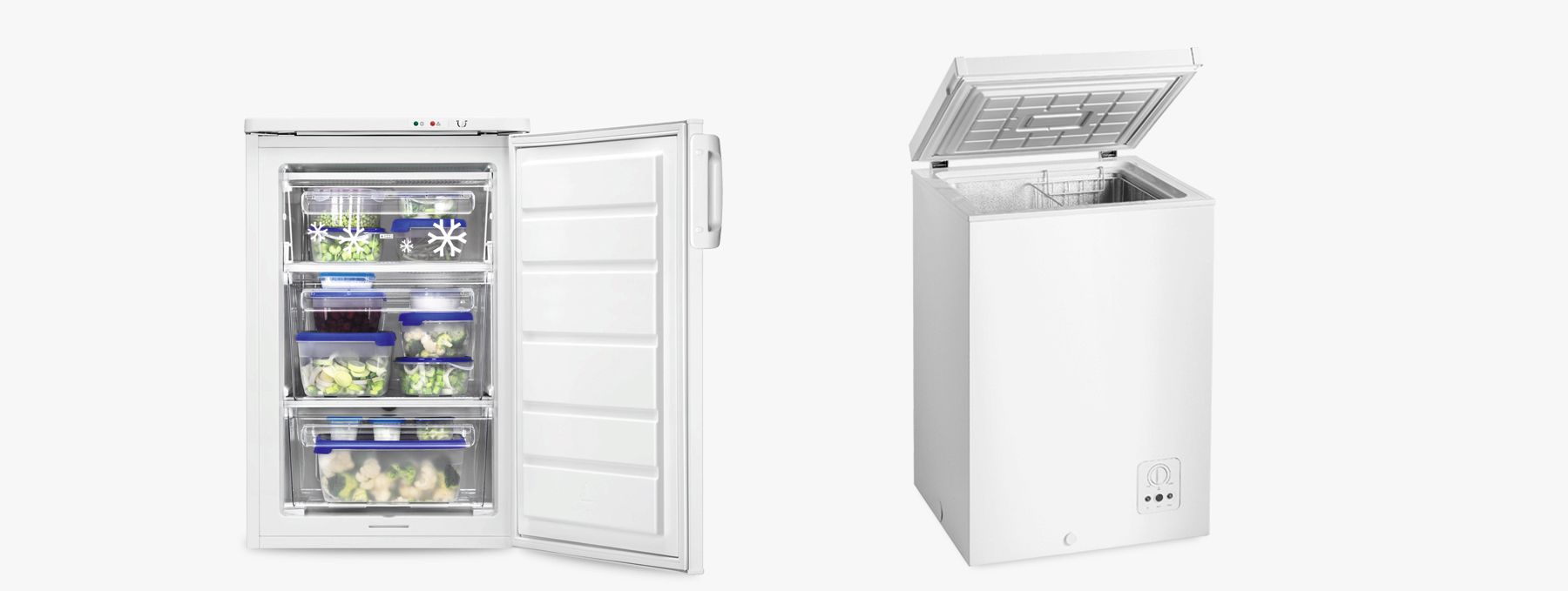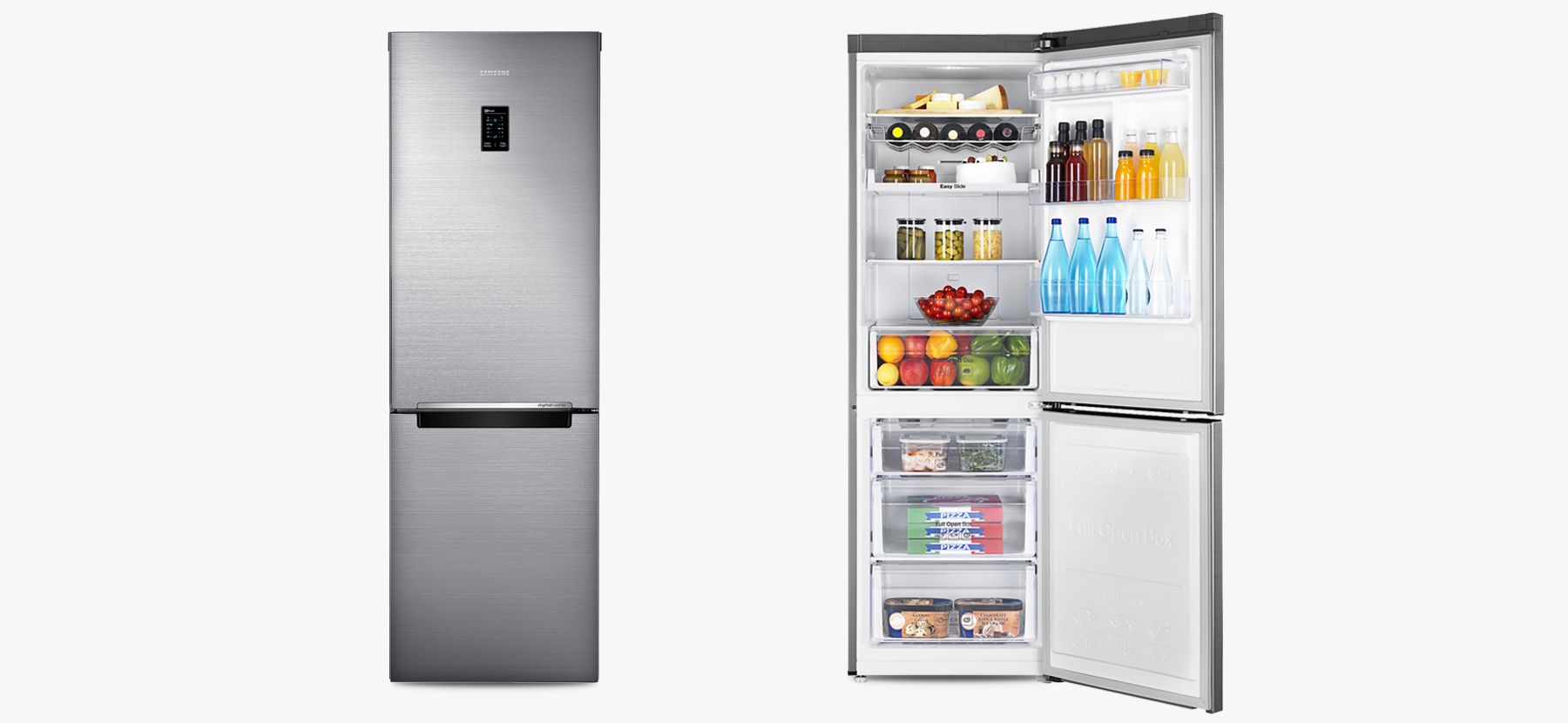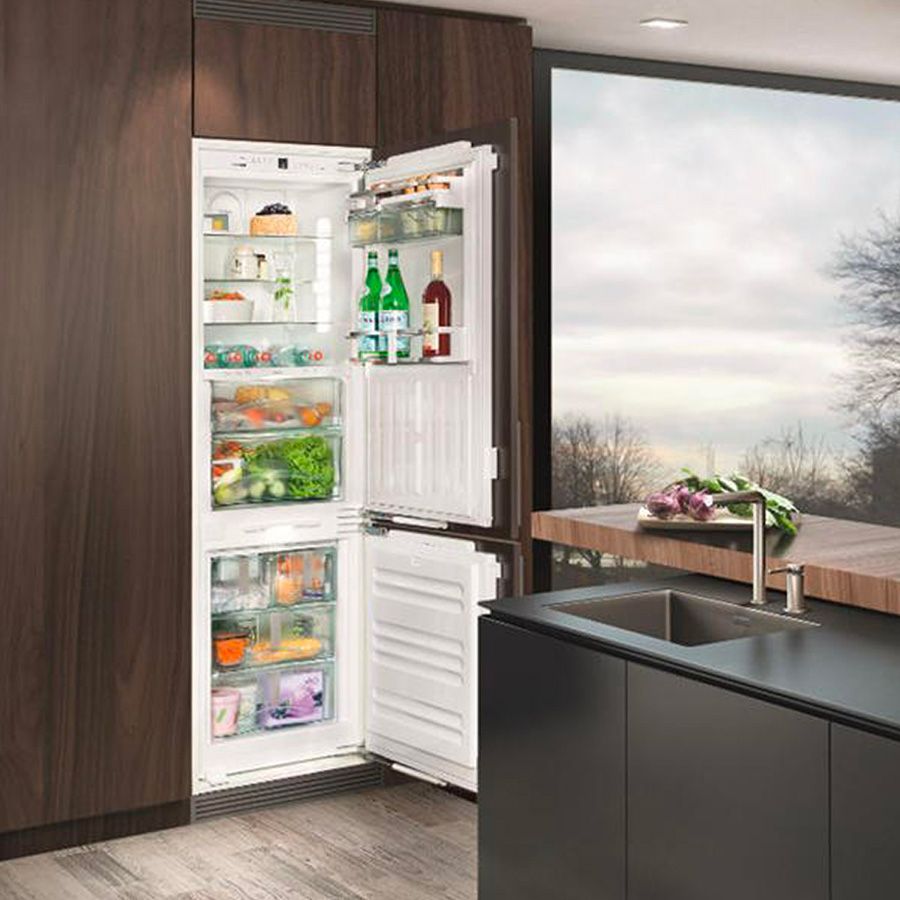Buying Guides

Buying a fridge freezer
From the weekly shop to that special bottle, here’s your guide to the fridges, freezers and wine cabinets that’ll keep your food and drinks fresh. Find tips on installation, energy efficiency and maintenance at the end of the guide
Types of fridges & freezers
The type of fridge or freezer you need will depend on the space you have and the appliances you already own.
Larder fridges
If you already have a freezer, a larder fridge will give you extra storage space ordinarily taken up by the freezer compartment. A larder will also automatically defrost itself, saving you time and effort.
Fridges with freezer compartments
A fridge with a freezer compartment is a great option if you only want to freeze a small amount of food at a time.
Freezers
How much freezing capacity you need will determine whether you buy a chest or upright freezer.
Upright freezers can normally live with the rest of your kitchen appliances as they'll usually be the same width as a fridge. Most people opt for these, and the size you choose will obviously depend on the size of your household and whether you'll do a lot of fresh food freezing or just need it for day-to-day convenience.
Chest freezers are often installed in utility rooms because of their size and their top opening lids. They work best for large households wanting to freeze food in bulk. Although they sometimes have wire baskets, they have no internal shelves, so organising food isn't as easy as with an upright fridge freezer with buckets or shelves.
Fridge freezers
A fridge freezer is the ideal solution if you're short on floor space but have height to spare and need more freezing capacity than the ice box offered by some conventional fridges.
Decide on the fridge and freezer capacities you need as the combination of these varies - and not all will have independent controls. Those that do ensure that you're not relying on the fridge thermostat to control the compressor for both appliances.
Some models have a 0ºC compartment in the fridge, useful for safe storage of chilled ready meals.
Large American-style fridge freezers are increasingly popular, because of both their huge capacities and dynamic styling.
They're tall and normally configured side by side with doors opening in opposite directions from the centre. They're frost-free and may have several cool zones at different temperatures. The freezer section usually has ice and chilled water dispensers, though remember that the appliance must usually be plumbed in within one metre of a water supply.
The size of the evaporator in these large appliances can create a slightly higher level of background hum than a conventional fridge freezer.
Integrated refrigeration
When considering an integrated refrigerated appliance, there are two ways of attaching the furniture door:
- A fixed/door-on-door fitting means that the cabinet door is attached and fixed to the integrated appliance door. There is only one set of strong hinges on the appliance used to support both the cabinet door AND the appliance door. Both doors move as one when opened as they are effectively ‘stuck’ together.
- A sliding fitting integrated appliance is only supporting the weight of its own door. The sliding mechanism ensures the appliance door will pivot inside the cabinet against the furniture door, both doors moving as two.
Read our built-in appliances guide for more information on integrated appliances.
What size do I need?
Integrated fridges & freezers
These types of appliance have a front panel that matches the rest of your kitchen units, so when the door is closed, the fridge or freezer will be completely hidden. Find out more about built-in appliances in our buying guide.
Freestanding fridges & freezers
Freestanding or upright models give you lots of options in terms of size, colour and design.
A standard fridge or freezer (H85cm) is useful if you don't have much space or it needs to be fitted under a countertop, while a tall fridge or freezer (over H130cm) offers maximum storage.
We also stock a range of compact fridges (up to H60cm), which are useful if you need extra storage space for drinks.
Features to look out for
Auto defrost
All larder fridges have auto defrost so you never have to manually defrost again. If you choose a fridge with an ice box, it will need to be defrosted periodically.
Antibacterial coating
Some fridges have an antibacterial coating on the walls and door that helps prevent bacteria growth, improving the hygiene in your fridge.
Fast freeze
All freezers have a fast freeze option to use when freezing freshly-prepared or recently-purchased food. This can be used to prevent the temperature in the freezer rising when warmer items are introduced into it, to preserve the quality of the food.
Some more advanced models will have automatic fast freeze, which cuts in if the temperature in the freezer becomes too warm, and turns off again when food is safely frozen.
Frost free
Frost-free freezers enable fast freezing in all compartments so no defrosting is necessary. As food freezes, no ice crystals are formed inside, which ensures better taste and nutritional content - even more importantly, you're saved the chore of regular defrosting.
Holiday mode
Some fridge models include a holiday mode, which ensures it operates in the most efficient way while you're away, saving energy and helping to reduce your bill.
Shelves & fixtures
Modern fridges now come with glass shelves, which avoid any danger of drips from food on a higher shelf contaminating food below. They're also really easy to clean.
Some fridges come with a wine rack or bottle holder and most fridges are equipped with an egg rack and compartments for butter and cheese. Shallow shelving in the fridge door allows storage of large bottles and jars.
Upright freezers are fitted with a set of shelves incorporating the evaporator tubes, which create freezing conditions. Food is stored either directly on a shelf with a flap at the front to help it stay put, or in wire or bin-type drawers mounted on the shelves.
The solid bin-type 'buckets' generally make a freezer a little more expensive, but they help retain cold air when the freezer door is open and so help reduce running costs because the compressor motor doesn't have to work so hard to keep a constant temperature.
Temperature
Temperatures will vary throughout your fridge, depending on the type you have. However, some larder fridges have a dynamic cooling system by which a built-in fan circulates cold air at about 5ºC.
This ensures less variation in fridge temperature and is especially useful when you've had the fridge door open for a while to unload shopping as the fan speeds up to restore a normal operating temperature.
Most freezers have a built-in thermometer so you can keep an eye on the temperature. Top of the range models will have this on the outside rather than the inside.
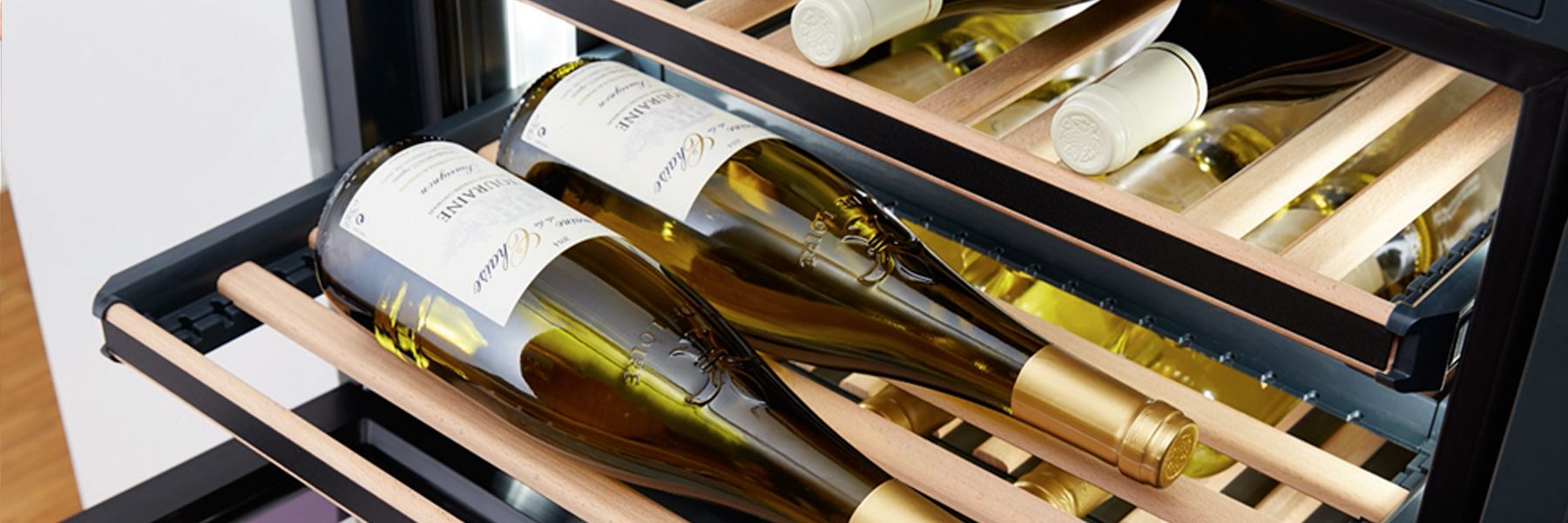
Choosing a wine cabinet
Few of us have a cavernous cellar in which to stock our wines. For most of us it’s either a question of finding some space under the stairs or in the kitchen. This is fine if you regularly drink inexpensive wine as it’s not meant to be kept, but if you plan to hold on to your wine, then you may like to consider a longer-term solution.
Why is it important to store wine correctly?
Wine is a constantly-developing drink. As such, it reacts well or badly to its surroundings. By keeping it in the correct conditions you’ll ensure the wine matures properly. Too warm and the wine will age faster; too cool and deposits may develop.
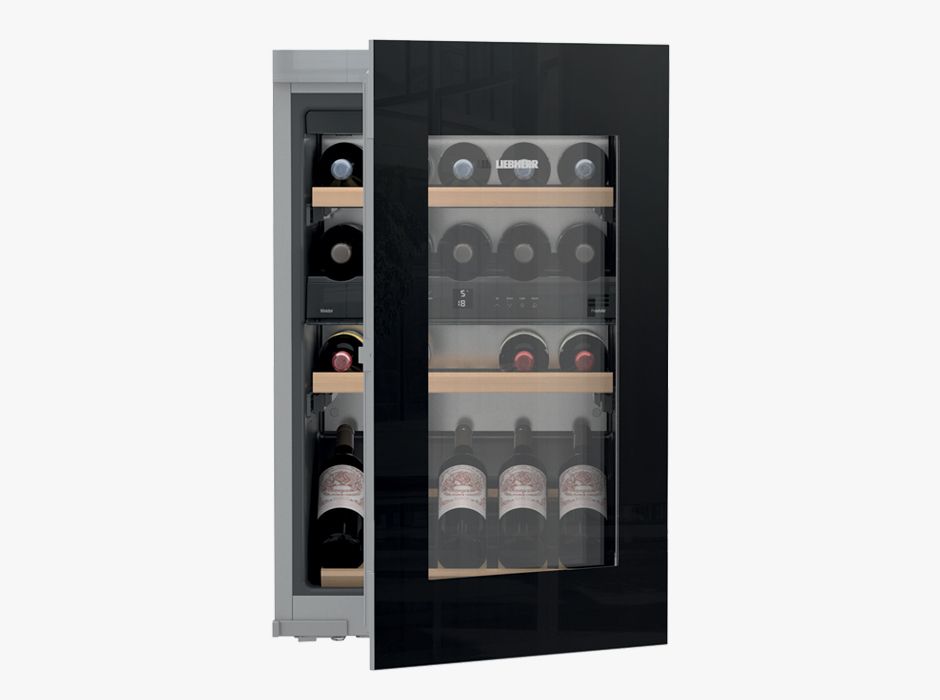
Tip
Bottles with corks should be stored on their side to keep the cork moist and prevent air from entering. Screw cap bottles and sparkling wines can be stored upright
Things to consider
Capacity
Think about how much you need to store: units that fit under worktops will carry no more than about 40 bottles. If you’re serious about buying wine for laying down or as an investment, go for the largest one you can.
Remember to consider the type of wine you buy: most units are designed to take Bordeaux bottles. If your taste is for champagne or Burgundy, with wider and thicker bottles, you’ll be able to store fewer.
Which wines do you drink?
Red and white wines require different storage temperatures. You generally store white wine at 10-12°C and reds at 12-16°C.
With top-of-the-range models you can programme independent temperatures within the unit, so you can keep champagne on the bottom shelf and claret on the top.
Humidity and cooling
Proper humidity is just as important: too dry and the corks will dry out; too damp and mould could form. Superior models will maintain the correct humidity, as well as keeping the air well ventilated. Some even have charcoal filters, which prevent contamination of the wine.
Proper ventilation is also important. Fan-cooled refrigeration also ensures that if you open the door the fridge quickly recovers its interior temperature and any odours are excluded, so the wine isn’t tainted.
Shelf configuration
Entry level models tend to have fixed shelving. Higher spec models have shelves you can roll out, making it easier to retrieve and inspect your bottles. Shelves can also be adjustable – useful if you want to store extra fizz for a party – and be made from wood or high-quality chrome.
Doors
Glass doors may let you show off your Chablis but they don’t insulate as well as solid doors. If you want a glass door, then check whether it’s UV protected. This means the wine won’t be affected by sunlight.
Where to store it
As with most fridges, you should try and keep them where the ambient temperature doesn’t fluctuate too much – so avoid the garage if you can. Wine cabinets can cope with temperature changes but big fluctuations put extra pressure on the unit.
Energy consumption
All of our wine cabinets are ‘E' or 'G' rated for energy consumption, since they are for longer term wine storage. Drinks fridges and wine coolers are currently exempt from classification.
Delivery, recycling, installation & disposal
If you live within the delivery area of a John Lewis shop (you can check your postcode on the specific product page), your new appliance will usually be delivered by one of our vans.
You'll also be able to arrange for collection and recycling of your old appliance so that we can dispose of it safely (excludes American-style fridge freezers). You need to booked and pay for disposal when you place your order, and we can only remove the old appliance if it has been disconnected.
Once your old appliance has been removed, it's deemed to have no value and we won't be unable to return it to you.
Alternatively, you can take your old appliance to a local recycling centre to be recycled free of charge.
Visit www.recycle-more.co.uk to find your nearest site (opens in a new window).
If you live outside a delivery area, or if you opt for a model delivered by one of our approved suppliers, then your new appliance will be delivered by a third-party courier. As they're unable to collect, you'll need to take your old appliance to a local recycling centre, or arrange for it be collected by your local council where offered.

DIY installation tips
If you're putting your fridge or freezer underneath a worktop, you must normally allow a gap of 25mm at the top, back and sides of the appliance so that the warm air produced by the condenser can be properly ventilated. Lack of ventilation will cause the compressor to work harder, resulting in faster frost build-up and wasting energy.
When installing your new fridge or freezer, keep it upright at all times and allow at least 6 hours for the gases inside to settle before switching on. It's best left overnight to reach the correct temperature before being loaded with food.
Please remember to make sure your fridge or freezer will fit into the intended space before ordering and that you've measured all access areas so that our drivers can deliver and locate your fridge successfully.
Tip
Manufacturers recommend you don't keep a fridge or freezer in the garage or any other outbuilding, as it may have to use much more energy. Most models require a minimum ambient temperature of 10°C (50°F) to operate efficiently, so it's safer to locate it in a utility room indoors
Maintenance
Taking care of your fridge or freezer is recommended to keep it running smoothly and prolong its lifespan. Always turn the power off at the mains and pull out the plug before you clean.
- Clean your fridge or freezer regularly
Use a damp, soapy cloth to clean your fridge and freezer shelves thoroughly on a regular basis. This keeps mould and smells at bay. You should defrost your freezer thoroughly before cleaning.
- Monitor the temperature
The optimum temperature for fridges is between 2.8°C and 4.4°C (never more than 5°C), while freezers should be set at around -18°C.
- Clean compressor coils at least every six months
The coils, found at the back or bottom of a fridge, can pick up grease, dust and dirt. Switch off the fridge and use a vacuum cleaner to remove excess dust, then wipe with a damp cloth.
- Make sure the doors seal properly
If residue builds up on the seals, you’ll have to tug the door open, which can damage them. If the doors don’t close completely, your fridge has to work harder to keep food cool, which affects its energy output. Simply wipe the seals down from time to time with a damp cloth and dry before closing. If the door still won’t close properly, it’s time to replace the seals.
- If you have a water dispenser, replace the filter in your fridge every 3 - 6 months
This prevents the buildup of contaminants in your water supply.
- When there’s a power cut, keep the door shut
This maintains a low temperature. If the appliance is without power for a while, check that food has not started to warm or defrost before you switch it back on.
Energy Efficiency
All new fridges and freezers are required to have energy efficiency ratings of between A and G. The wine cabinets and mini fridges we stock are rated between E and G.
Standardised tests, monitored by Trading Standards, are carried out by manufacturers, who are responsible for grading their appliances.
You might also want to check out our YourEko tool. Designed to help you make informed decisions, it highlights the life-time running costs of your machine.
You'll often find that the more expensive the appliance, the better the running costs because energy-saving features such as thicker insulation, automatic door closing or 'door open' audible alerts will be included.
Your home energy consumption may vary from the figure quoted, owing to factors such as:
how well stocked the appliance is (it works better when it's full)
its location (the ambient temperature affects how hard the motor has to work to keep a consistent temperature)
how well ventilated it is (again, the better the ventilation, the less hard the motor has to work)
how airtight it is - keep door seals clean
All refrigerated appliances we stock are free of CFCs (chlorofluorocarbons, potentially damaging to the ozone layer), and also free of HFCs (hydrofluorocarbons, which may have an effect on global warming).
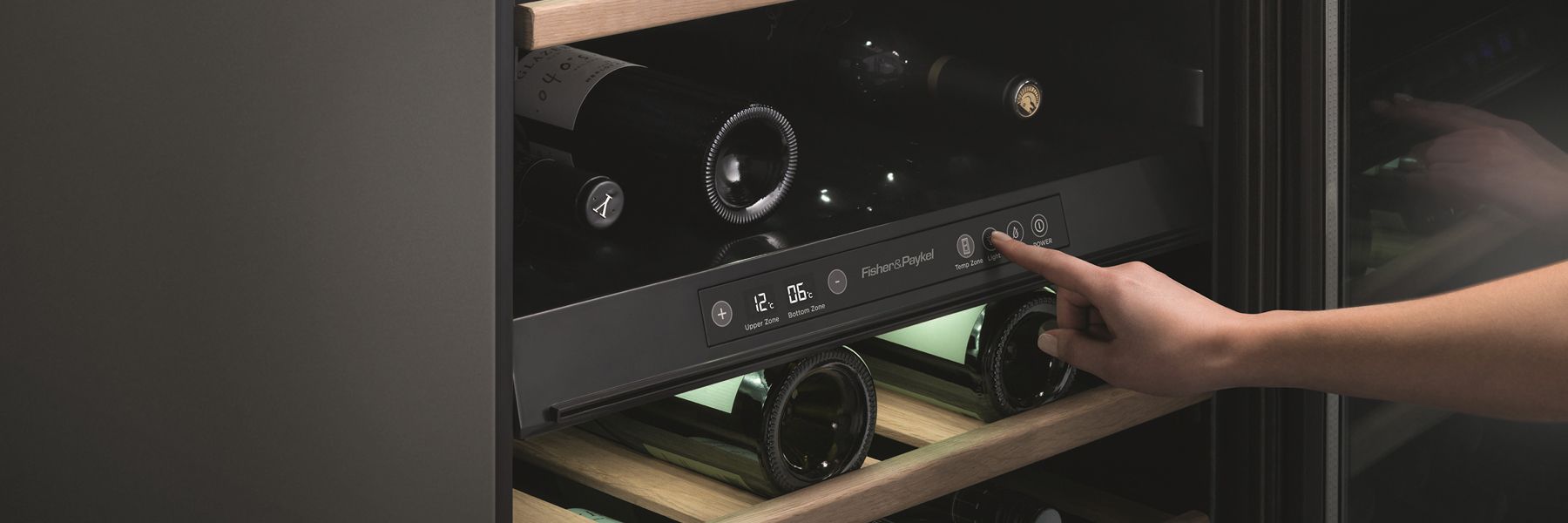
Guarantee
Our 2-year guarantee
All large appliances you buy from us are guaranteed for a minimum of 2 years, at no extra cost. John Lewis appliances are guaranteed for 3 years.
Added Care
With Added Care, you'll enjoy the same benefits for a period of up to 5 years, while also adding further benefits not included in the original guarantee.
PARTNERSHIP CARD
Our rewards credit card gives you 1.25% back in points towards vouchers when you shop with us.


PARTNERSHIP CARD
Our rewards credit card gives you 1.25% back in points towards vouchers when you shop with us.
John Lewis plc, 171 Victoria Street SW1E 5NN acts as a credit broker. Credit provided under exclusive arrangements with the lender John Lewis Financial Services Limited

